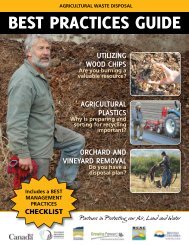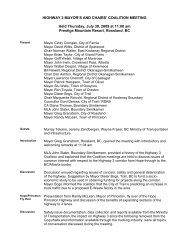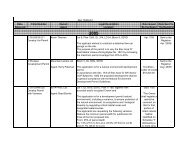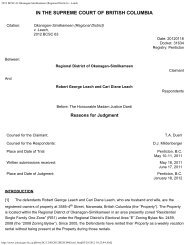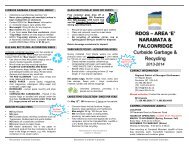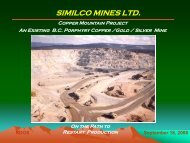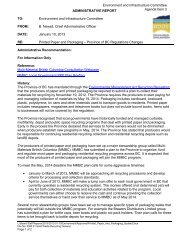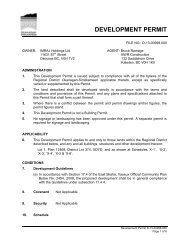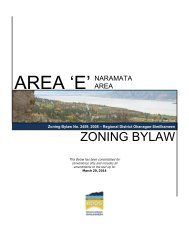Regional Heritage Strategic Plan 2013 - Rdosmaps.bc.ca
Regional Heritage Strategic Plan 2013 - Rdosmaps.bc.ca
Regional Heritage Strategic Plan 2013 - Rdosmaps.bc.ca
Create successful ePaper yourself
Turn your PDF publications into a flip-book with our unique Google optimized e-Paper software.
These themes <strong>ca</strong>n be adapted to create a thematic framework tailored to any community. It is important to understand<br />
that themes must be relevant to all people, places, and times in a community’s evolution. For example,<br />
hunting may be a subtheme related to Developing Economies for a community. While different groups may<br />
value hunting for different reasons, and have hunted in different ways at different times, it is a common thread<br />
that has always been relevant to the people who live (and have lived) in this place. A true theme will resonate<br />
with all periods of a community’s history, and with all of the inhabitants of that community over time.<br />
WORKSHOP FORMAT<br />
The format of the workshop includes two parts:<br />
1. Identifying community heritage values.<br />
2. <strong>Heritage</strong> Asset/ Historic Place Mapping<br />
Both of these activities help to establish a values-based foundation for the development of a community heritage<br />
planning program.<br />
Identifying community heritage values – Participants are assigned to random groups, and asked to answer a series<br />
of questions related to the five contextual themes on large pieces of paper on the walls of the workshop<br />
rooms. The five theme questions were:<br />
1. Why did, and do, people live here<br />
2. How and why is the community’s historic and current economic development important to its heritage<br />
3. How and why is the community’s historic and current role as an administrative centre signifi<strong>ca</strong>nt<br />
4. What is, and has been, special about the social and community life here<br />
5. What is unique about the community’s expressions of intellectual and cultural life over time<br />
Participants may also be asked to answer the question “why is heritage conservation important to the community”<br />
The result of this exercise <strong>ca</strong>n be a series of statements related to each question; statements that begin<br />
to build an understanding of what it is about the community’s history and quality of life through all of its periods<br />
of development that people value today.<br />
The second part of this exercise is a “ranking” process. Participants are given a series of “dot” stickers and asked<br />
to spend time reading all of the responses at each of the six question stations. They are then asked to place<br />
their dots (five per question) by the statements that they felt best <strong>ca</strong>ptured the essence of that theme in terms<br />
of the community’s heritage. They are allowed to place all of their dots on one statement, or distribute them as<br />
they please among a number of statements.<br />
Mapping – The second exercise allows participants to visually represent on maps the physi<strong>ca</strong>l places in the community<br />
that embody the heritage of each theme. Large maps should be set up at each theme station, along with<br />
instructions on how to mark the maps for different types of places. Participants <strong>ca</strong>n mark areas, specific places,<br />
transportation routes or corridors, or views with the following markings.<br />
Use to identify areas of<br />
heritage value.<br />
Use to identify specific<br />
places of heritage<br />
value.<br />
Use to identify transportation<br />
routes relevant to heritage<br />
values.<br />
Use to identify views which<br />
are important for retaining<br />
and understanding heritage<br />
values.<br />
inspire honour transform<br />
www.for.gov.<strong>bc</strong>.<strong>ca</strong>/heritage Page 3<br />
<strong>Regional</strong> <strong>Heritage</strong> Strategy | Request for Proposals August <strong>2013</strong> | 37





